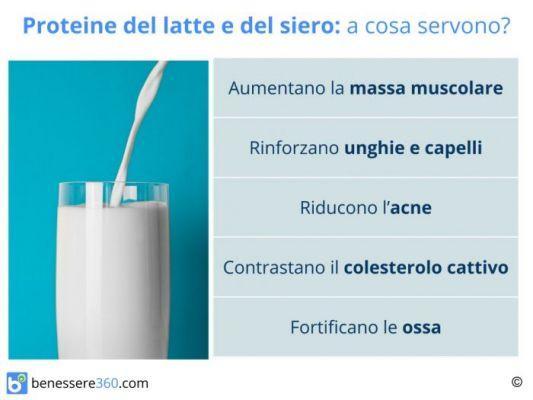
La casein and whey they are both milk-derived proteins and by-products of cheese making, but they have some differences.
What are casein and whey
Casein e whey are the two types of proteins found in cow's milk, which costituiscono respectively 80% and 20% of milk proteins.
They are high quality proteins, as they contain all essential amino acids for maintaining health and are easily digestible.
Both casein and whey are by-products of cheese production.
During cheese making, special enzymes or acids are added to the heated milk that cause the casein in the milk to clot or turn into a solid state, separating itself from a liquid substance. This liquid substance is whey protein, which is then washed and dried into a powdered form for use in food or dietary supplements.
The remaining casein curd can be washed and dried to create a protein powder or added to dairy products, such as cottage cheese.
They don't have the same absorption
One of the differences most significant between casein and whey protein is the speed with which the body absorbs them.
Casein protein is digested slowly, whey is digested quickly. These differences in absorption rates make the proteins of the casein best to hire before bedtime and those of the siero of ideal milk with a view to a training because they stimulate the muscle building process.
All the benefits
Casein and whey contain various bioactive peptides, which are beneficial to the body.
Those of the casein they proved useful to the immune and digestive system and also benefit the health of the heart, lowering blood pressure and reducing blood clot formation.
In addition, they bind to and transport minerals such as calcium and phosphorus, improving their digestibility in the stomach.
The proteins of the siero milk, on the other hand, contain a series of active proteins called immunoglobulins, which enhance the immune system. Animal and test-tube studies have also shown that these proteins exert effects antioxidants and inhibit the growth of tumors and cancer, as well as transporting important nutrients, such as vitamin A, and improving the absorption of other nutrients, such as iron.
The many qualities of proteins
In general, what matters more than anything else is thetotal daily protein intake, as these are incredibly important elements for health.
Their functions, in fact, are different: they carry out chemical reactions in the body, remove foreign particles such as viruses to help fight infections, coordinate cell signals, provide shape and support to the skin, bones and tendons and move substances, between which hormones, medicines and enzymes, through the body.
In addition to basic nutritional functions, they bring many other benefits, including aiding fat loss, decreasing appetite and increasing metabolism, and improving blood sugar control in people with type 2 diabetes when consumed in place of carbohydrates. Furthermore, several studies show that people who consume the most protein, regardless of the source, have the lowest blood pressure.
These benefits are associated with higher protein intake in general, not necessarily casein or whey.
Which ones to choose
Despite their different bioactive components, whey and casein proteins vary little when it comes to nutritional data.
a standard measuring cup of 31 grams, whey protein contains:
- Calories: 110
- Fat: 1 gram
- Carbohydrates: 2 grams
- Protein: 24 grams
- Iron: 0% of the Reference Daily Intake (RDI)
- Calcium: 8% of the RDI
standard measuring cup of 34 grams, casein protein contains:
- Calories: 120
- Fat: 1 gram
- Carbohydrates: 4 grams
- Protein: 24 grams
- Iron: 4% of the RDI
- Calcium: 50% of the RDI
These nutritional values may vary depending on the specific product, so it is advisable to read the labels carefully.
When choosing which one is best to take as a supplement, there are other factors to consider.
- Casein protein powders are generally more expensive than whey.
- Whey protein powders tend to mix better than casein.
- Whey protein powders often have a better texture and taste than casein.
Choosing one solution over the other won't necessarily give better results in the gym or significantly improve your health, so head for the one you prefer or buy a blend that contains both.
How to use them
These protein powders they can be mixed with water or milk. Milk will make protein shakes, especially those with casein, thicker.
If possible, mix the protein powder and liquid with a blender rather than a spoon, so that the final texture is smoother and the protein distribution more even.
Always add liquid first, this order will prevent proteins from sticking to the bottom of the container.


























